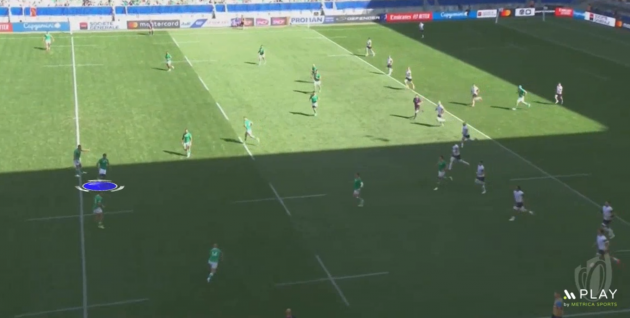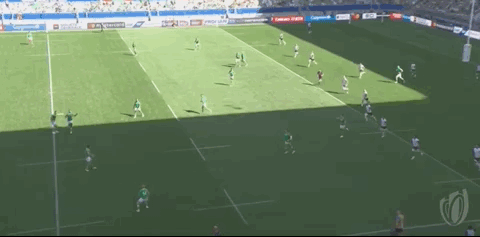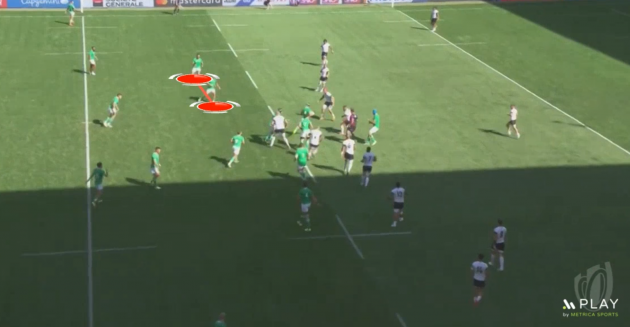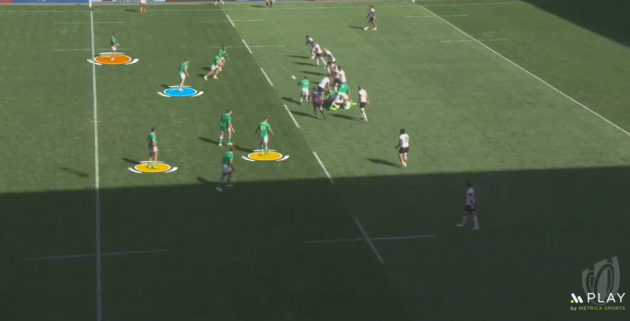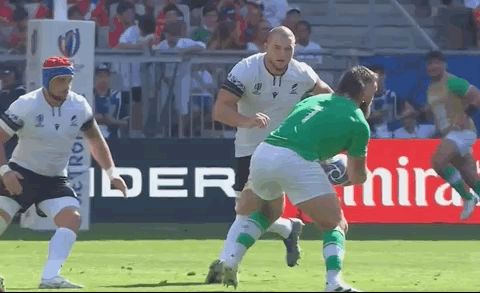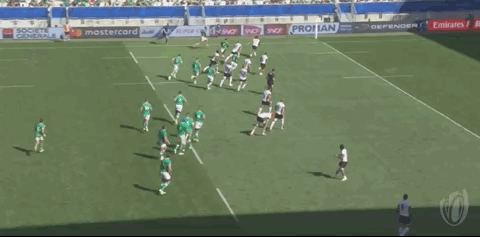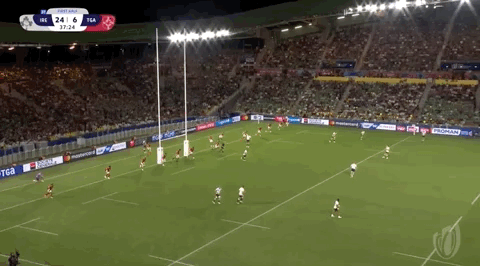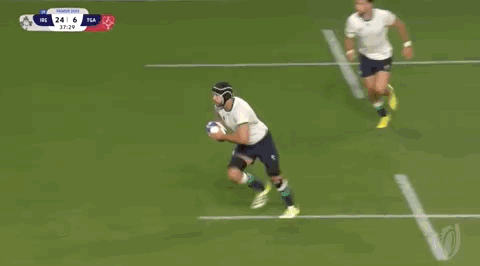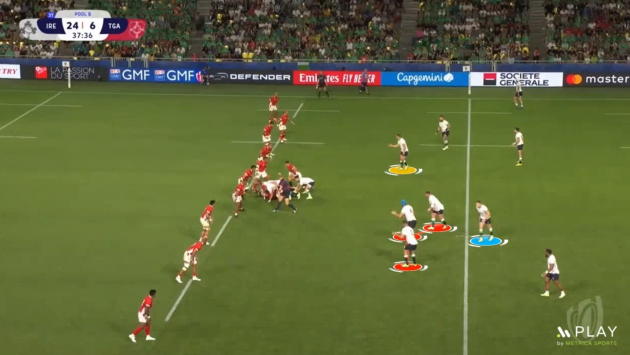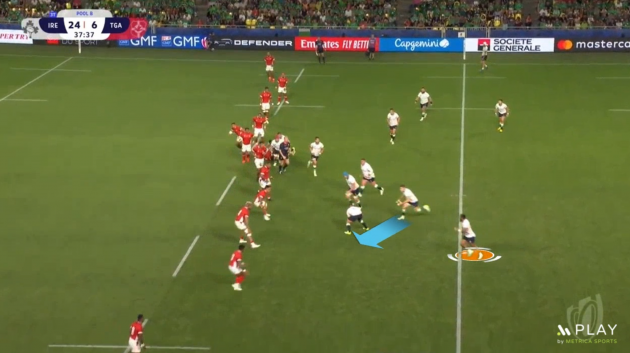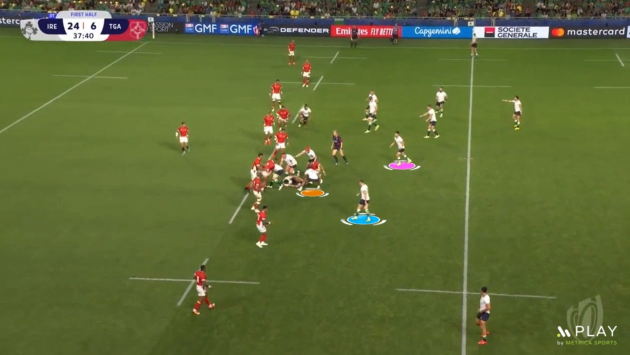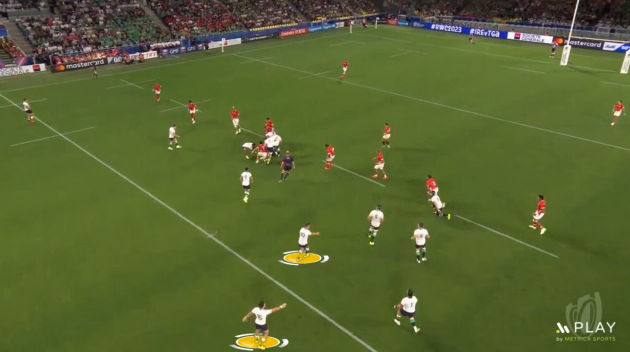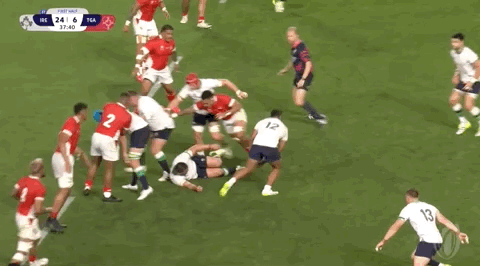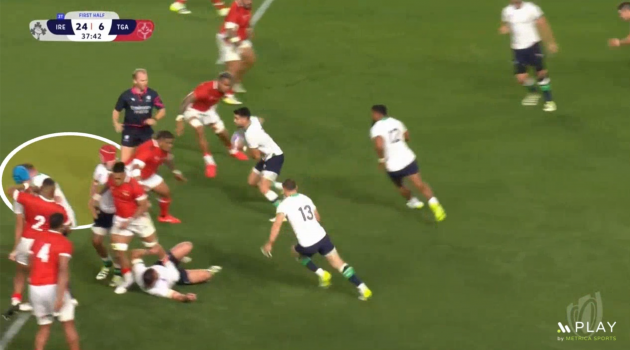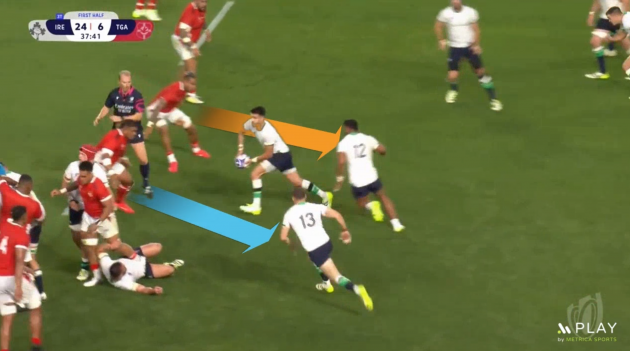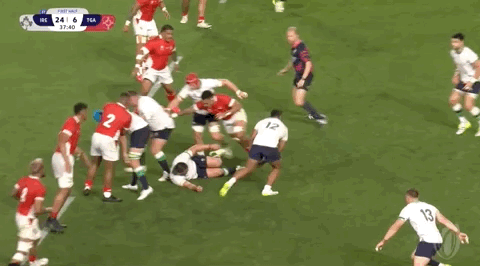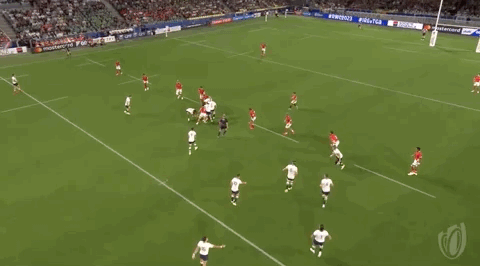WHEN A TEAM is starting to hum, their set-piece attack often begins to deliver big returns. The pieces fall into place, the timing is just right, the plan is pulled off. Ireland are in that boat.
Andy Farrell’s side were razor-sharp with some of their set-piece plays against Tonga last night, most notably for Johnny Sexton’s wonderful first-half try. It was a record-breaking moment, but also a sign that Ireland are continuing to level up.
While scrum and lineout have traditionally been the platforms for set-piece strikes and power plays [intricate moves that unfold over several phases], the goal line drop-out has more recently presented teams with a chance to plot and plan.
Ireland scored a superb try against France in this year’s Six Nations with a power play from a goal line drop-out, with fullback Hugo Keenan scorching through to score off Finlay Bealham’s delayed inside pass as Conor Murray ran a dummy loop. You can read our analysis of that try here.
Last weekend against Romania, Ireland also scored with a set-piece move from a goal line drop-out, with Bundee Aki the man to score.
Keith Earls received the drop-out and with Johnny Sexton pointing at Caelan Doris [purple below], he instantly passed inside to his number eight.
As against France earlier this year, Doris is designated to make the first carry, using his power and footwork to set a central platform for Ireland to strike off on the next phase.
Doris carries strongly into midfield.
As Doris is carrying the ball, hooker Rob Herring and loosehead prop Andrew Porter [red below] are setting up in a two-man pod to the left, ready for the second phase of Ireland’s attack.
While that pair of forwards are readying themselves, Ireland’s backs are also busy getting into position.
As we can see below, centre Garry Ringrose [blue] has moved behind but just infield of the pod of two forwards, while midfield partner Bundee Aki [orange] is wider to his left.
Meanwhile, out-half Johnny Sexton and fullback Keenan [yellow above] are on the right side of the ruck, providing a possible passing option there and keeping some of the Romanian defenders occupied.
However, Ireland’s plan is for scrum-half Jamison Gibson-Park to pass to Porter on the edge of the two-man pod, with Ringrose darting late to swing behind and beyond Porter.
Porter’s pass close to the defence is slick and Ringrose’s late run means the defenders don’t get an early cue as to where he’s going to end up.
As we can see above, that means Ringrose then has time to draw in the second-last defender and send Aki into space.
Porter’s pass is worth another look.
Ringrose’s draw-and-pass means one of the Romanian second rows has to try to catch-up from the inside.
Aki dummies a pass to James Lowe to force the last Romanian defender to sit off him and he outpaces the chasing lock to score.
Aki could and perhaps should have passed inside to Gibson-Park to ensure an easier conversion but backed himself to finish while moving at high speed.
It’s a slick Irish score and it was always going to be intriguing to see what happened the next time Farrell’s side received a goal-line drop-out.
We only had to wait a week as Tonga cleared their line after Irish hooker Rónan Kelleher was held up from a maul effort. As soon as that happened, Ireland would have called the clever play we saw unfold next.
Tonga clear long and it’s Doris who directly receives the restart, meaning Ireland don’t have to pass to him.
Doris once again carries with intent, using his footwork to get into a slightly more central position.
Josh van der Flier, James Ryan, and Peter O’Mahony’s first roles are to resource the breakdown, ensuring a clean recycle.
Rather than a two-man pod to the left, this time we see a three-man pod of forwards made up of Tadhg Furlong, Tadhg Beirne, and Kelleher [red below].
Again, Ringrose [blue above] is hovering behind, ready to make the same darting run, while Sexton [yellow] and Keenan have held on the right-hand side to occupy defenders there.
The initial movement from Ireland is familiar, with Ringrose swinging out the back [blue below] of Kelleher as he receives a pass from scrum-half Murray on the edge of the pod, with Aki [orange] slightly wider.
Kelleher has to stoop to gather the ball from Murray and then he dummies a pass out the back to Ringrose, rather than dropping that same vertical pass to him as Porter did against Romania.
The temptation is to think that Kelleher just didn’t want to pass after having to stoop, while we can also see that the Tongan defence is far better set up to defend that option.
But really, Ireland have a new layer to this play, meaning it’s planned for Kelleher to hang onto the ball.
As noted below, Ringrose [blue] stays on the left-hand side as a possible receiver there as Aki [orange] goes to the breakdown to act as the scrum-half, with Murray [pink] standing off to the right.
Outside Murray, Ireland are much more animated this time.
Now below how Sexton and Keenan [yellow] are directing Ryan, O’Mahony, and Doris into shape as they retreat from the previous breakdown.
This is distracting for the Tongan defence, who must worry about Ireland playing out to that wide right-hand side.
But Ireland have planned to strike just to the fringe of the breakdown.
Aki passes to Murray and runs a loop line around him, while Ringrose hares up on Murray’s inside after swinging from the left at a very late stage.
While that’s happening, there’s subtle work being done at the breakdown, where Beirne, Furlong, and van der Flier [highlighted below] make themselves big to ensure that none of the Tongan defenders involved can fold across to Ireland’s right.
Nothing here is obvious enough to be a penalty for obstruction, but it certainly magnifies the chance for Ireland on the right fringe.
All of the above means that Murray finds himself in a 3-on-2 situation and he makes an excellent decision.
Tonga lock Leva Fifita reads onto Aki’s dummy loop line [orange below], while loosehead prop Siegfried Fisi’ihoi picks out Ringrose [blue] arriving late into this channel.
That means Murray can dummy to further sell the inside option to Fisi’hoi and burst through himself, draw in opposite number Augustin Pulu and throw the delayed pass to Ringrose, who has pushed past Fisi’hoi.
Of course, Sexton knows the entire plan here and he’s pre-empting the linebreak close to the breakdown.
He doesn’t want to go too early on his support line upfield, therefore giving Tonga a cue that something’s up, but we can see below how he sprints forward as soon as the dummy loop play is in motion.
Sexton is one of four players who flood through in support of Ringrose, with Aki swinging up after his dummy loop, Beirne coming forward from the breakdown, and left wing Lowe working up over on the far side.
Sexton works hard and shows his pace to be an option for Ringrose, who does well to swerve to his right and draw in Tonga out-half William Havili before passing to Sexton.
The Ireland out-half then cleverly steps off his right foot to take him back inside Tonga fullback Charles Piutau for an excellent finish.
This wasn’t the only set-piece try Ireland scored against the Tongans but it was the highlight of the game both for Sexton’s achievement and the cohesive brilliance from Ireland collectively.
They continue to add layers to their attack and South Africa will be wary next weekend.

